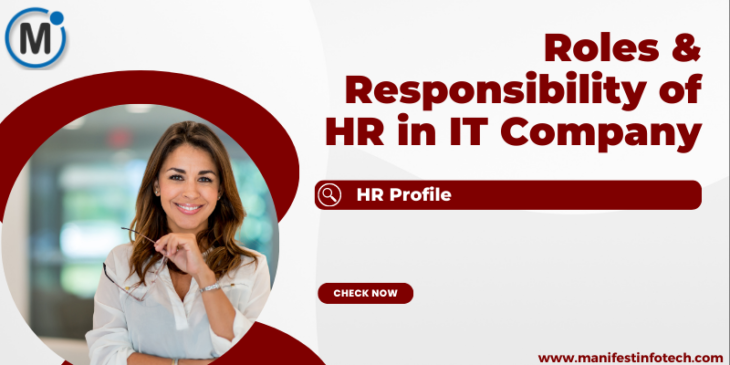
In an IT company, the Human Resources (HR) department plays a crucial role in managing various aspects of the workforce, ensuring that the organization can effectively attract, develop, and retain talent while maintaining a positive work environment. Here are some common roles and responsibilities of the HR department in an IT company:
𝟏. 𝐓𝐚𝐥𝐞𝐧𝐭 𝐀𝐜𝐪𝐮𝐢𝐬𝐢𝐭𝐢𝐨𝐧 𝐚𝐧𝐝 𝐑𝐞𝐜𝐫𝐮𝐢𝐭𝐦𝐞𝐧𝐭:
– Collaborating with hiring managers to define job requirements and create accurate job descriptions.
– Sourcing and attracting qualified candidates through various channels, including job boards, social media, and professional networks.
– Conducting interviews, assessments, and screenings to evaluate candidates’ technical and cultural fit.
– Managing the recruitment process, from job posting to offer negotiation and onboarding.
𝟐. 𝐎𝐧𝐛𝐨𝐚𝐫𝐝𝐢𝐧𝐠 𝐚𝐧𝐝 𝐎𝐫𝐢𝐞𝐧𝐭𝐚𝐭𝐢𝐨𝐧:
– Ensuring a smooth onboarding process for new hires, including providing necessary paperwork, access to systems, and introduction to company culture.
– Conducting orientation sessions to familiarize new employees with the company’s policies, values, and work environment.
𝟑. 𝐏𝐞𝐫𝐟𝐨𝐫𝐦𝐚𝐧𝐜𝐞 𝐌𝐚𝐧𝐚𝐠𝐞𝐦𝐞𝐧𝐭:
– Collaborating with managers to set clear performance expectations and goals for employees.
– Conducting regular performance reviews and providing constructive feedback to help employees grow and improve.
– Identifying high-performing employees and facilitating recognition and rewards.
𝟒. 𝐓𝐫𝐚𝐢𝐧𝐢𝐧𝐠 𝐚𝐧𝐝 𝐃𝐞𝐯𝐞𝐥𝐨𝐩𝐦𝐞𝐧𝐭:
– Identifying training needs and organizing relevant technical and professional development programs for employees.
– Offering opportunities for skill enhancement, certifications, and workshops to ensure employees stay up-to-date with industry trends.
𝟓. 𝐄𝐦𝐩𝐥𝐨𝐲𝐞𝐞 𝐑𝐞𝐥𝐚𝐭𝐢𝐨𝐧𝐬:
– Addressing employee concerns, grievances, and conflicts in a timely and professional manner.
– Promoting a positive work environment by fostering effective communication and teamwork.
𝟔. 𝐂𝐨𝐦𝐩𝐞𝐧𝐬𝐚𝐭𝐢𝐨𝐧 𝐚𝐧𝐝 𝐁𝐞𝐧𝐞𝐟𝐢𝐭𝐬:
– Administering compensation packages, including salary reviews, bonuses, and benefits such as health insurance and retirement plans.
– Conducting market research to ensure the company’s compensation structure remains competitive within the industry.
𝟕. 𝐏𝐨𝐥𝐢𝐜𝐲 𝐃𝐞𝐯𝐞𝐥𝐨𝐩𝐦𝐞𝐧𝐭 𝐚𝐧𝐝 𝐂𝐨𝐦𝐩𝐥𝐢𝐚𝐧𝐜𝐞:
– Developing and maintaining HR policies and procedures that align with legal requirements and industry standards.
– Ensuring compliance with labor laws, data protection regulations, and other relevant regulations.
𝟖. 𝐄𝐦𝐩𝐥𝐨𝐲𝐞𝐞 𝐄𝐧𝐠𝐚𝐠𝐞𝐦𝐞𝐧𝐭 𝐚𝐧𝐝 𝐑𝐞𝐭𝐞𝐧𝐭𝐢𝐨𝐧:
– Creating and implementing initiatives to enhance employee engagement and job satisfaction.
– Conducting employee surveys, feedback sessions, and other methods to gauge employee sentiment and make improvements accordingly.
𝟗. 𝐃𝐢𝐯𝐞𝐫𝐬𝐢𝐭𝐲 𝐚𝐧𝐝 𝐈𝐧𝐜𝐥𝐮𝐬𝐢𝐨𝐧:
– Promoting diversity and inclusion within the workplace, fostering an environment that values different perspectives and backgrounds.
𝟏𝟎. 𝐄𝐱𝐢𝐭 𝐌𝐚𝐧𝐚𝐠𝐞𝐦𝐞𝐧𝐭:
– Managing the offboarding process when employees leave the company, including conducting exit interviews and ensuring a smooth transition.
𝟏𝟏. 𝐇𝐑𝐈𝐒 𝐌𝐚𝐧𝐚𝐠𝐞𝐦𝐞𝐧𝐭:
– Maintaining and updating the Human Resources Information System (HRIS) to ensure accurate employee records, payroll processing, and reporting.
If you are looking for any services related to Website Development, App Development, Digital Marketing and SEO, just email us at nchouksey@manifestinfotech.com or Skype id: live:76bad32bff24d30d
𝐅𝐨𝐥𝐥𝐨𝐰 𝐔𝐬:
𝐋𝐢𝐧𝐤𝐞𝐝𝐢𝐧: linkedin.com/company/manifestinfotech
𝐅𝐚𝐜𝐞𝐛𝐨𝐨𝐤: facebook.com/manifestinfotech/
𝐈𝐧𝐬𝐭𝐚𝐠𝐫𝐚𝐦: instagram.com/manifestinfotech/
𝐓𝐰𝐢𝐭𝐭𝐞𝐫: twitter.com/Manifest_info
#HRinIT #ITCompanyHR #HRRoles #HRResponsibilities #TechHR #ITWorkforce #TalentManagement #EmployeeRelations #ITRecruitment #TechTalent #HRDevelopment #HRTraining #ITPerformance #WorkplaceEngagement #HRCompliance #TechCulture #DiversityInTech #ITEmployeeRetention #HRLeadership #HRInnovation #ITCompensation #HRBestPractices #TechOnboarding #HRDataProtection #ITExitManagement